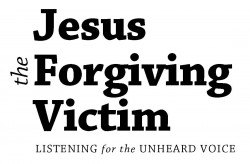Part 2 – Home
Jesus the Forgiving Victim Part 2: God, not one of the gods
Congratulations on completing Part 1, Starting human, staying human. Part 2, God, not one of the gods dives into the Bible, what James sometimes jokingly calls the big bad book. Part 2 consists of 6 modules.
| Module 1 | The Stoning of Achan | |
|---|---|---|
| When we read Scripture through the eyes of the Forgiving Victim we cannot help but see things from the victim’s perspective, even if the story is told from the point of view of the persecutors. We will read such a story in this module, the story of the stoning of Achan found in Joshua chapter seven. | ||
| Unit 1 | Welcome to Part 2: God, not one of the gods | |
| Unit 2 | 2.1 The stoning of Achan: Reading Scripture through new eyes | |
| Unit 3 | 2.1 The stoning of Achan: Listen and share | |
| Unit 4 | 2.1 The stoning of Achan: Wrap-up | |
| Module 2 | Prophecy and interpretation | |
| We will explore problems with two different approaches to reading Scriptures: the Marcionite way of reading and the fundamentalist approach. Then we will see that by approaching Scriptures as a progressive revelation, we can discover new and more true things about God and ourselves. | ||
| Unit 1 | 2.2 Prophecy and interpretation: Receiving a new story | |
| Unit 2 | 2.2 Prophecy and interpretation: Reading the mysteries backwards | |
| Unit 3 | 2.2 Prophecy and interpretation: Listen and Share | |
| Unit 4 | 2.2 Prophecy and interpretation: Wrap-up | |
| Module 3 | Interpretation in the Scriptures | |
| The struggle around interpretation is not imposed upon Scriptures, but something that happens within them. For a rather important example, we’ll look at the different interpretations offered by Jeremiah and Ezekiel around the question of God’s involvement with child sacrifice. | ||
| Unit 1 | 2.3 Interpretation in the Scriptures: Receiving a new story | |
| Unit 2 | 2.3 Interpretation in the Scriptures: Understanding sacrifice | |
| Unit 3 | 2.3 Interpretation in the Scriptures: Listen and Share | |
| Unit 4 | 2.3 Interpretation in the Scriptures: Wrap-up | |
| Module 4 | The final edition | |
| Monotheism emerges in the texts of 2nd Isaiah, but it was a late development. We will look at how the Hebrew Scriptures are not, strictly speaking, monotheistic. | ||
| Unit 1 | 2.4 The final edition: Receiving a new story | |
| Unit 2 | 2.4 The final edition: Let’s talk about the Old Testament | |
| Unit 3 | 2.4 The final edition: Listen and Share | |
| Unit 4 | 2.4 The final edition: Wrap-up | |
| Module 5 | Priests and prophets | |
| We will explore the process by which it became possible to put distance between God and human victim-making. We will see the movement in Scriptures away from systems of religious purity and of the notion that historical calamity is a punishment for sin. | ||
| Unit 1 | 2.5 Priests and prophets: Receiving a new story | |
| Unit 2 | 2.5 Priests and prophets: Experiencing God and Creation | |
| Unit 3 | 2.5 Priests and prophets: Listen and share | |
| Unit 4 | 2.5 Priests and prophets: Wrap-up | |
| Module 6 | God’s utter aliveness | |
| Notions of morality and racial purity appear as the exiles return from Babylon to Jerusalem. Prophetic writings and the Wisdom literature kept alive a different understanding, that of God’s utter aliveness and the opening up of Creation from within the Holy Place in the Temple. | ||
| Unit 1 | 2.6 God’s utter aliveness: Receiving a new story | |
| Unit 2 | 2.6 God’s utter aliveness: Walk down memory lane | |
| Unit 3 | 2.6 God’s utter aliveness: Listen and share | |
| Unit 4 | 2.6 God’s utter aliveness: Wrap-up | |
